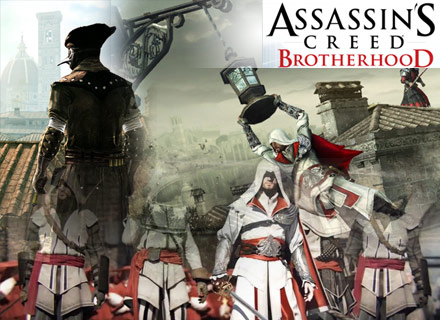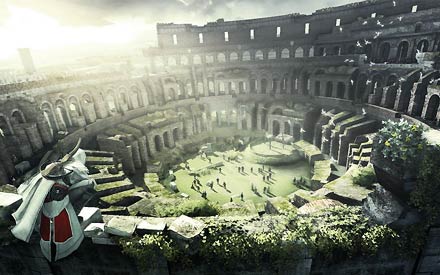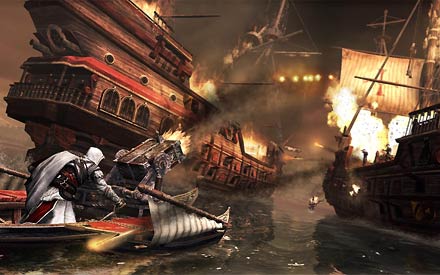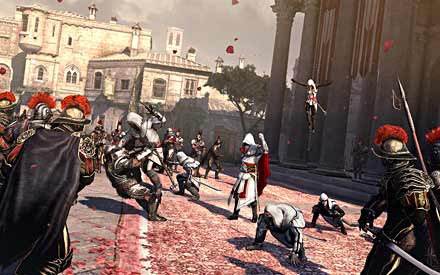Historically speaking, who rinsed the vast spanning urban cities of medieval ages when the crooked terrorized the Mediterranean neighborhood? Ezio Auditore da Firenze. Or at least, Ubisoft has us thinking so as we review Assassin’s Creed Brotherhood. As the third installment of the series, ACB presents itself as a very close sequel to Assassin’s Creed II without breaking any utterly new grounds, except for the multiplayer component, and a brand new apprentice system that appears to be somewhat of a needless integration.

While ACII featured an abundance of fresh gameplay content widened across the newly ventured Italian Renaissance setting, ACB pummels the nail into the same old feature wall, only just a little bit higher. However, players will get to experience a blood rush equivalent to that of ACII as Ezio retaliated with an avenging spree for the familial deaths caused by a corrupted Borgia overture.
Brotherhood shoots off with sequences that follow Desmond in present day Italy giving the DNA exploring time-traveler a bit more on-screen action than Assassin’s Creed II. Players will see him and Lucy leaping from ridges to crinkles and creases in the cracked up underground of the Monteriggioni villa, to find a way for their colleagues so that they can setup a hideout safe from any external intrusions by Abstergo. As soon as Desmond plugs in the Animus, Ezio returns to Monteriggioni following his long journey of self-discovery and reckoning from the templar order.
But inevitably, his deeds trail him with prolonging after-effects in Assassin’s Creed Brotherhood as the Spaniard Rodrigo Borgia’s son Cesare Borgia launches a full-fledged assault over the Villa, killing Ezio’s uncle Mario and stealing the Apple of Eden. The Tuscan countryside faces destruction at the hands of his army alongside destroying all of Ezio’s tediously earned armor and weaponry. Thus begins the Assassin’s journey on a quest of revenge yet again in Assassin’s Creed: Brotherhood.

Leaving behind the city in ruins, Ezio travels to Rome seeking to retrieve the Apple and assassinate Cesare Borgia and his father to end their malevolence once and for all. ACB depicts Rome in all its glory with antiquated remains of the Coliseum on one end and hills overshadowing the colonies at the other. Every time Ezio perches up a ledge extruding from one of the high-rising towers of Rome, awe-inspiring vistas of the city unfold across a wide hazy horizon with populated remnants of its breathing life.
With dancing prostitutes, shouting heralds, non-remissive guards and mouthy beggars, the in-game world never ceases to etch a plausible impression, either of a hastily built inn in the shady districts of Rome or of a gracefully crafted palazzo for higher order officials to host a lavish revelry at. Graphically, ACB presents itself as a worthy extension to the previous game with slightly more refined textures, similarly realistic environments and an ever-evolving sky-dome.
ACB’s AI mechanics and combat dynamics tend towards being a slow attrition where Ezio is still progressively gnawing away at the infamous Borgia power. And honestly, the all-too-powerful assassin could have done it much quicker had he willed to do so. There is some certain degree of commonality in how Ezio’s story develops and extrapolates the events in ACII, but what Brotherhood lacks is the newness component which could stay faithful to the one that its precursor brought.

To exemplify for instance, the underground Assassin tombs from the previous game are replaced with the Lairs of Romulus. This comparison is in no way meant to undermine the amount of fun it is to play through these, as they are similarly designed with ensnaring puzzle rooms that require an extra effort of thought to reach respective objectives. While the lairs had us sharing sporadic resemblances to the experience that Prince of Persia invoked, players will find themselves spending much of their time on such pre-requisites which aid the plot of the game.
Rogue civilians can be recruited by players as Assassin apprentices and Ezio can send them on contractual missions all throughout the game. Using them as a means to a target’s end will gradually enable them to level-up and outfit incrementally potent armor and weapons. Rome is split into 12 districts, each with its own authoritative Borgia overseer and a Borgia tower which Ezio has to eliminate and burn before he can assign one of his own apprentices to the area.
Doing this will largely benefit players later in the game as it reduces the amount papal army force roaming around the region, and also opens up access to one of the many tunnel entrances running underground the city that can be utilized to travel to and fro without having to do it manually. Moreover, the blacksmith, doctor, tailor and other shops open up in the freed district resulting in a considerable raise of Ezio’s overall income, not to mention the increased accessibility of weapons, health potions and the likes.

Even though pursuing targets and taking them out in one of the stylish ways persists on and off as a diminishing fun element, the cyclic nature of beating, mugging and stabbing soon starts feeling invariably painstaking. It’s rather tempting just to measure rooftops up to the enemy territory, have each of them in Ezio’s field of view, and pick them out one by one by signaling an apprentice. This infuses a much needed variety in the gameplay. As said earlier, the game doesn’t really need it, in the sense that the ability to recruit and call-up assassins whenever opportunity presents just seems as a substitute for the feebleness of the game’s narrative which rarely explores anything out of the ordinary. Nevertheless, it is still an enjoyable experience and makes one feel like they are in absolute control of the ongoing events.
The singularity of ACB’s campaign mode is coupled with an unforeseen multiplayer component. Although not categorically perfect, it bogs down to being an essentially entertaining mode to play, wherein players choose from one of the Templars training in the Abstergo facility and hunt opponents across various different maps. Each participant is assigned a target at the start of the game which they have to assassinate before time runs out, but the catch is that he cannot play offensive against his own pursuer. Ironically, it’s not so much linear as it sounds. Ubisoft has ported few of the crafty evasion tactics present in the single-player over to the multiplayer which will keep gamers on their toes and the circular prey-play, spiced up.
Final Word: In its entirety, Assassin’s Creed Brotherhood hits the right spot by delivering about the same and sometimes even more levels of immersion and core gameplay features that Assassin’s Creed II had. And therefore, has no sizeable surprising factor in and of itself. With stellar amounts of horse-riding, stealth-sneaking and crowd-blending, ACB seems to be walking a thin line between a gorgeous sequel to one of the most fantastic games of 2009 and a monotonous cash-in repertoire. And if it weren’t for the stylishly improvised action moves, absorbing side-missions and the precedent acts of parkouring across an expansive city, the game would have easily stumbled over. But then again, Assassin’s Creed Brotherhood does what a sequel is supposed to do, that is, to stand up to all the assurances that its predecessor’s success demands. So at the end of the day, it has left us greatly impressed, flaws and all.
Graphics: 8/10.
Game Sounds: 8.5/10.
Environments: 7.5/10.
Gameplay: 7/10.
Story: 7/10.
Replay Value: 8/10.
Overall (not an average): 7.5/10.

